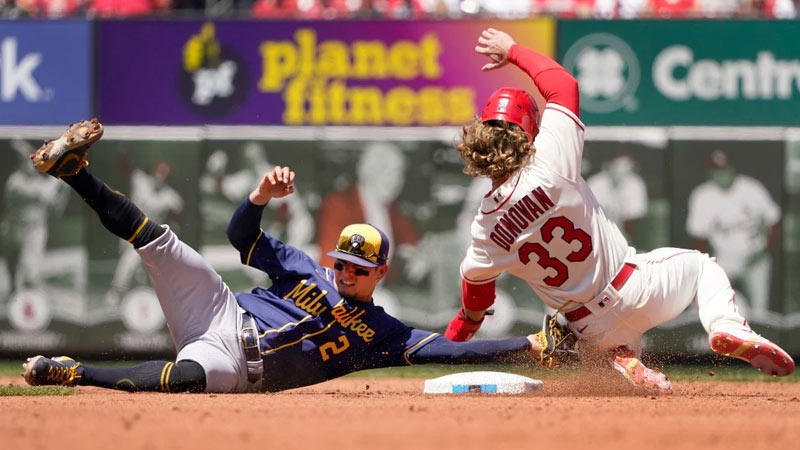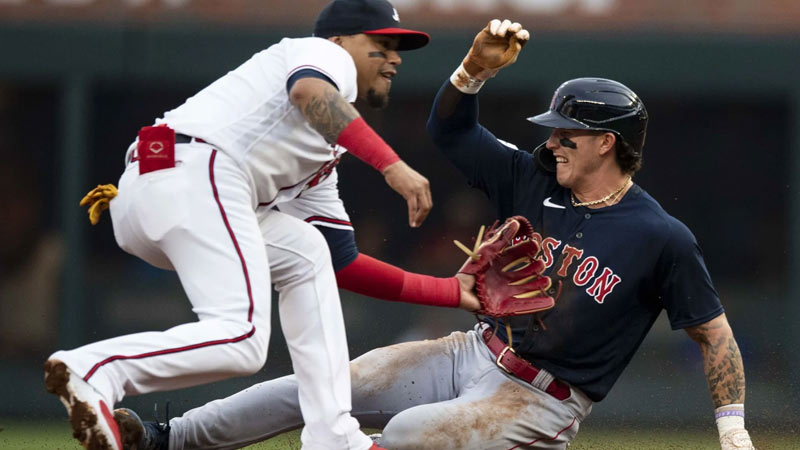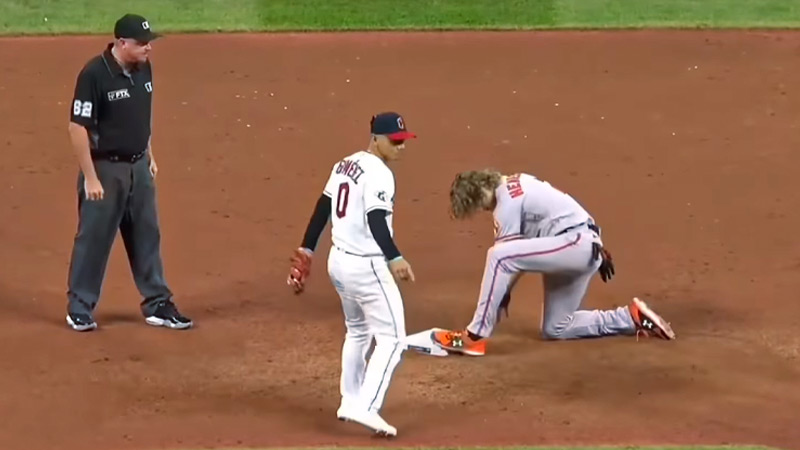In the exhilarating world of baseball, stolen bases add a thrilling dimension to the game, showcasing a player’s speed, skill, and strategic acumen. Stolen Base Percentage is a key statistic that quantifies a player’s success rate in stealing bases, offering insights into their effectiveness as baserunners.
This blog post delves into the concept of Stolen Base Percentage in baseball, exploring how it is calculated, its significance in evaluating players’ baserunning abilities, and some of the best examples of players with impressive stolen base percentages in the history of Major League Baseball (MLB).
Whether you’re a baseball enthusiast seeking to enhance your understanding of the game’s intricacies or a newcomer keen to learn more, this post will provide you with valuable insights into the art and science of stealing bases. Stay focused.
What Is Stolen Base Percentage?
Stolen Base Percentage is a statistic used in baseball to measure a player’s success rate in stealing bases. It represents the percentage of successful stolen base attempts compared to the total number of attempted steals.
Stolen bases are a strategic and exciting aspect of the game, where a baserunner attempts to advance to the next base while the pitcher and defense try to prevent it by throwing the ball to the base before the runner reaches.
How to Calculate Stolen Base Percentage in Baseball?

Source: sports.betmgm.com
Calculating Stolen Base Percentage in baseball is a straightforward process that involves simple arithmetic based on a player’s successful stolen bases and caught stealing attempts. The formula for determining Stolen Base Percentage (SB%) is as follows:
Stolen Base Percentage (SB%) = (Successful Stolen Bases / (Successful Stolen Bases + Caught Stealing)) x 100
To calculate a player’s Stolen Base Percentage, follow these steps:
Step 1: Identify the Successful Stolen Bases
Count the number of times the player successfully stole a base during a given period, such as a season, a series, or a career.
Step 2: Identify the Caught Stealing
Count the number of times the player was caught stealing a base during the same period.
Step 3: Calculate the Stolen Base Percentage
Divide the number of successful stolen bases (Step 1) by the sum of successful stolen bases and the number of times the player was caught stealing (Step 2). Then, multiply the result by 100 to convert it into a percentage.
For example, let’s consider a player who successfully stole 30 bases during a season but was caught stealing 10 times:
SB% = (30 / (30 + 10)) x 100 = (30 / 40) x 100 = 0.75 x 100 = 75%
In this example, the player’s Stolen Base Percentage is 75%, indicating that they successfully stole bases in 75% of their attempted steals during that season.
Stolen Base Percentage provides valuable insights into a player’s baserunning efficiency and helps assess their ability to make strategic decisions on the basepaths.
What Is the Good Stolen Base Percentage?

Source: thebiglead.com
A good stolen base percentage in baseball is a benchmark that indicates a player’s effectiveness as a baserunner. The 70% threshold is widely accepted as a favorable percentage, suggesting that the player successfully steals bases more often than not.
When a player’s SB% hovers around or exceeds 70%, it reflects their ability to make strategic decisions, time their steals well, and capitalize on their speed to outmaneuver the defense.
However, it’s essential to consider that the definition of a “good” stolen base percentage can be relative and context-dependent. Different factors can influence how a player’s SB% is perceived:
Player’s Role on the Team
The significance of the stolen base percentage can vary depending on the player’s role within the team’s overall strategy. For example, a leadoff hitter’s primary job is to get on base and create scoring opportunities.
In this case, a higher stolen base percentage may be more critical, as they are expected to be a disruptive force on the basepaths. On the other hand, for power hitters lower in the batting order, stolen bases might not be as crucial to their role.
Overall League Average
The average stolen base percentage across the league can also influence how a player’s individual percentage is perceived. If the league’s average stolen base percentage is notably lower than 70%, a player who consistently achieves a 70% or higher SB% might be regarded as an exceptional baserunner.
Game Situation and Context
The context in which stolen bases occur can impact the evaluation of a player’s SB%. Stealing bases in crucial situations, such as during tight games or high-pressure moments, can be particularly valuable for a team.
A player who excels at stealing bases when it matters most might be highly regarded, even if their overall percentage is slightly below 70%.
Other Baserunning Skills
Stolen bases are just one aspect of baserunning. A player’s overall baserunning skills, including the ability to take extra bases on hits, read the pitcher’s moves, and advance on wild pitches or passed balls, contribute to their value as a baserunner.
A player with a slightly lower stolen base percentage but strong overall baserunning skills may still be highly appreciated for their contributions on the basepaths.
MLB Rule on Stolen Base Percentage
While Major League Baseball (MLB) does not have a specific rule that dictates a required stolen base percentage for players, the statistic holds significant importance in the game.
Stolen Base Percentage serves as a valuable tool for teams and managers when formulating strategic decisions on the field.
Player Evaluation and Roster Decisions
Stolen Base Percentage is a crucial factor when evaluating players and making roster decisions. Coaches and managers assess a player’s baserunning abilities, including their SB%, to determine their value as an asset on the team.
Players with a high stolen base percentage demonstrate efficiency and success in stealing bases, making them more likely to earn starting positions or gain a spot on the active roster.
Strategic Game Planning
Managers utilize Stolen Base Percentage as part of their game planning and strategy. Understanding a player’s success rate in stealing bases helps determine when to attempt stolen bases during a game.
In close contests, a successful steal can change the course of the game, putting pressure on the defense and potentially creating scoring opportunities.
The decision to Green Light Players
The concept of “green light” refers to the permission given to certain players to attempt stolen bases whenever they see an opportunity. A player’s stolen base percentage plays a crucial role in whether they receive the green light or not.
Players with a high SB% are more likely to be given the freedom to steal bases whenever they feel confident in doing so, trusting their baserunning instincts.
Balancing Aggressiveness and Efficiency
Stolen Base Percentage is not the sole determinant of whether a player should attempt steals. Managers must strike a balance between aggressiveness and efficiency on the basepaths.
Even if a player has a high SB%, other factors, such as the game situation, the opposing pitcher’s ability to control the running game, and the risk of getting caught stealing, are also considered when making strategic decisions.
Adapting to Game Situations
Stolen Base Percentage provides valuable information for teams to adapt their strategy based on the specific game situations and the skills of the players involved.
In certain games or against specific opponents, managers may adjust their approach to the running game, utilizing the talents of players with high SB% to exploit weaknesses in the defense.
List of the Best Stolen Base Percentages in MLB
As of my last knowledge update in September 2021, some of the best-stolen base percentages in MLB history include:
Tim Raines – SB%: 84.7%
Tim Raines, known as “Rock,” was an exceptional baserunner and had a remarkable career stolen base percentage. He ranks among the all-time leaders in stolen bases.
Carlos Beltran – SB%: 87.7%
Carlos Beltran was known for his speed and baserunning skills. His high stolen base percentage showcases his ability to pick the right moments to steal bases successfully.
Chase Utley – SB%: 88.4%
Chase Utley, a second baseman, was known for his all-around skills, including his baserunning. His impressive stolen base percentage highlights his smart and efficient approach on the basepaths.
Willie Wilson – SB%: 84.2%
Willie Wilson was known for his blazing speed, and his stolen base percentage reflects his ability to capitalize on his speed to steal bases successfully.
Eric Davis – SB%: 84.1%
Eric Davis was a dynamic outfielder with exceptional speed and power. His high stolen base percentage demonstrates his prowess as a baserunner.
FAQs
How is the Stolen Base Percentage calculated in baseball?
The Stolen Base Percentage is calculated using the formula: SB% = (Successful Stolen Bases / (Successful Stolen Bases + Caught Stealing)) x 100.
This formula measures the ratio of successful stolen base attempts to the total number of attempts, providing a percentage that represents a player’s efficiency in stealing bases.
What does a high Stolen Base Percentage indicate about a player’s baserunning skills?
A high Stolen Base Percentage indicates that a player is a proficient and successful baserunner. Players with a high SB% are strategic in their attempts, choosing the right moments to steal bases, and possess both speed and excellent instincts on the basepaths.
Is there an ideal Stolen Base Percentage that players strive for?
A successful Stolen Base Percentage typically falls around 70% or higher. While there isn’t an ideal percentage that all players strive for, an SB% in this range is generally considered a good benchmark for an effective baserunner.
How does Stolen Base Percentage impact a team’s strategy in baseball?
Stolen Base Percentage plays a crucial role in a team’s strategy during a game. Managers and coaches consider a player’s SB% when deciding whether to attempt stolen bases, which bases to steal, and when to give players the green light to run.
A high SB% can lead to more aggressive baserunning, putting pressure on the opposing team’s defense.
Who are some of the players with the best Stolen Base Percentages in MLB history?
As of my last knowledge update in September 2021, some notable players with impressive Stolen Base Percentages in MLB history include Tim Raines, Carlos Beltran, Chase Utley, Willie Wilson, and Eric Davis.
These players’ exceptional baserunning skills have solidified their place among the all-time leaders in stolen bases.
Conclusion
Stolen Base Percentage is a fundamental statistic that sheds light on a player’s baserunning prowess and efficiency in stealing bases. A high SB% showcases a player’s ability to execute successful steals while displaying strategic acumen and speed on the basepaths.
Managers and coaches factor in this statistic when making crucial decisions during a game, contributing to their team’s overall strategy.
The players with the best Stolen Base Percentages in MLB history have left an indelible mark on the sport, showcasing their exceptional talents and influencing the way the game is played.
As baseball continues to evolve, the significance of the Stolen Base Percentage remains a key aspect that enhances the excitement and allure of America’s cherished pastime. Best of luck.







